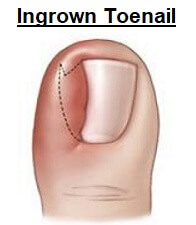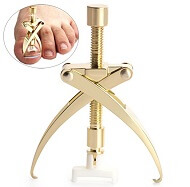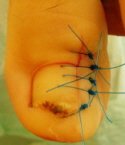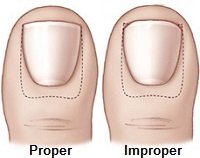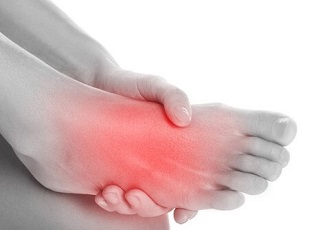- Home
- Common Foot Problems
- Ingrown Toenails
Ingrown Toenail Treatment
Written By: Chloe Wilson BSc(Hons) Physiotherapy
Reviewed By: FPE Medical Review Board
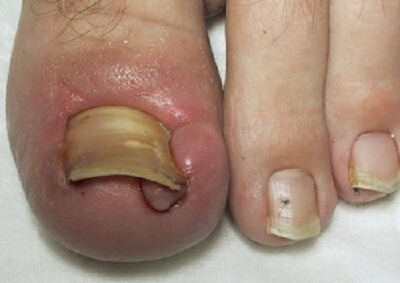
Ingrown toenail treatment can usually be carried out effectively at home.
An ingrown toenail is a common cause of toe pain where the edges of the nail push into the surrounding skin causing pain, inflammation and sometimes bleeding. They usually affect the big toe.
The medical terms for it are an "Onychocryptosis" or "Unguis Incarnatus".
The most common ingrown toenail causes are wearing tight shoes, a foot injury, genetics or poor foot care and hygiene. The skin around the edge of the nail becomes inflamed and painful and there may be some bleeding.
Whilst ingrown toenail treatment is relatively simple, if it is not started quickly, it may become infected and in severe cases, surgery may be required.
Here, we will look at what an unguis incarnatus is, the common causes, symptoms and ingrown toenail treatment options as well as how to prevent them coming back.
What Is An Ingrown Toe Nail?
An ingrown toenail develops when one or both of the curved side edges of the nail are pushed into the surrounding skin.
As the pressure increases, the nail pierces through the skin causing pain, inflammation, tenderness and redness. If bacteria enter through the cut in the skin, it may become infected.
A true onychocryptosis or unguis incarnatus is when the nail has actually cut into the skin, rather than just placing pressure on it.
Ingrown Toenail Causes
The most common ingrown toenail causes are:
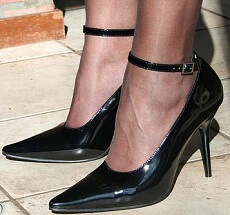
- Tight Footwear: Wearing tight fitting shoes, especially with a narrow toebox or shoes that are too short, exerts more pressure on your toes making them more prone to onychocryptosis
- Genetics: Some people have more naturally curved toenails making them more prone ingrown toenails
- Injury: One-off injuries, such as stubbing or dropping something heavy on your foot, or activities placing repetitive pressure on the toe such as repeated kicking or running can often lead to an unguis incarnatus
- Poor Nail Cutting: Cutting your nails too short, or rounding them at the side rather than cutting them straight across results in the surrounding skin starting to fold over the nail. The nail then grows into that skin resulting in an ingrown toenail
- Nail Infections: Fungal infections can cause thickening of the nail making it easier for it to pierce the skin
- Excessive Sweating: This can cause softening of the surrounding skin making it easier for the nail to cut in
Ingrown toenails can affect anyone but are most common in teenagers, as their feet sweat more and in the elderly, as nails get more brittle with age.
Ingrown Toenail Symptoms
In the early stages, an ingrown toenail causes only mild irritation. The toe may feel tender to touch and appear slightly red and swollen but symptoms gradually increase as the condition progresses. The most common symptoms of an unguis incarnatus are:
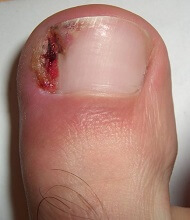
- Pain: around the toe, especially when pressure is placed on it
- Redness: around the edge of the nail, particularly if there is an infection
- Inflammation: swelling in the surrounding areas gradually increases. Initially there tends to be inflammation of the skin but you may end up with a build-up of fluid around the toe
- Pus: if bacteria causes an infected ingrown toenail, there may be yellow or white pus oozing from the area
- Bleeding: in severe cases, the nail may cut through the skin enough to cause bleeding
- Excessive Skin Growth: Extra skin can start to grow over the nail known as hypertrophy
Symptoms tend to get gradually worse so it is important to start ingrown toenail treatment as soon as possible.
Ingrown Toenail Treatment
Ingrown toenail treatment can usually be carried out at home however, if there are signs of infection or your symptoms fail to settle, you should always consult your doctor. This is also the case if you suffer from diabetes.
There are two main options with ingrown toenail treatment:
1. Ingrown Toenail Home Remedies
A common question we are asked is "Can I treat an ingrown toenail myself?" In most cases the answer is yes! Ingrown toenail treatment can often be carried out easily and effectively at home using a combination of:
- Nail Correction Tools: There are various ingrown toenail correction tools on the market that work really well to reposition, reshape and file the nail. They are designed for home use and receive excellent reviews making them a popular ingrown toenail treatment tool. Available on Amazon >
- Trim Nails: A very simple yet important ingrown toenail treatment is to ensure you are cutting your nails properly. You want to cut straight across instead of tapering or rounding the edges, and not cut too short. In some cases, you may need to use specially designed ingrown toenail clippers
- Change Footwear: Wear comfortable shoes that are wide enough not to put pressure through the toes, or when possible go barefoot
- Foot Soaks: Soaking your feet daily in warm water for 15-20 minutes ensures good hygiene and helps reduce pain and inflammation. You can use a bowl or home foot spa and you may want to add salts/oils to help really clean the feet. One of the most relaxing ingrown toenail home remedies!
- Massage: Gently roll away any excess skin away from the top of the nail with a cotton bud. It can help to use a small amount of olive oil to soften the skin
- Painkillers: Over the counter painkillers and anti-inflammatory medication can help to reduce the discomfort and swelling as part of your ingrown toenail treatment. Always consult your doctor before taking medication
If these ingrown toenail home remedies fail to resolve the problem within a week, you will need to see your doctor or a podiatrist as you may have developed in an infected ingrown toenail. It may be that you require minor surgery as part of your ingrown toenail treatment.
2. Surgical Options
There are two types of surgical ingrown toenail treatment commonly performed on an Unguis Incarnatus:
Partial Nail Avulsion
Partial nail avulsion ingrown toenail surgery is where part of the nail is removed, known as a wedge resection. The area is numbed with local anaesthetic and then one or both edges of the nail are trimmed. This makes the toenail narrower and gives it a straight edge, making it less likely to pierce the surrounding skin.
Any pus is also drained away from the ingrown toenail. A chemical such as phenol is used to prevent the nail re-growing. A wedge resection is a successful ingrown toenail treatment in approximately 98% of cases and takes approximately thirty minutes.
Total Nail Avulsion
Total nail avulsion ingrown toenail surgery is where the entire nail is removed. Total nail avulsion is also carried out under local anaesthetic and is most commonly performed on people who suffer from repeated problems or failed to respond to other ingrown toenail treatment.
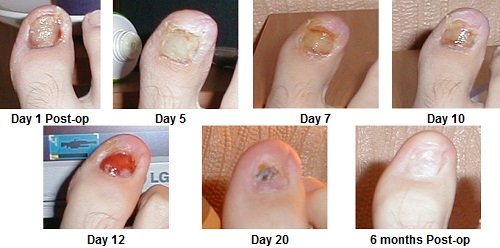
Surgical ingrown toenail treatment to remove all or part of a nail is known collectively as an "Onychecotomy".
Ingrown toenail surgery is usually carried out at your doctors (or podiatrists) surgery. The wound will be bandaged and you can go straight home. You may be given antibiotics to prevent the risk of infection and told to soak the foot to aid healing.
You may need to rest for 1-2 days keeping your foot elevated and walking to a minimum after an Onychecotomy. Often there is very little pain but in some instances the foot may feel sore so it is worth talking to your doctor about suitable painkillers following ingrown toenail surgery.
Recovering From Ingrown Toenails
Ingrown toenails can last from a few days to several weeks depending on the severity of the condition.
With the correct ingrown toenail treatment, it typically takes 1-2 weeks for the nail to heal. During this time, it is important to keep the area clean and dry to promote healing. You may also need to apply antibiotic ointments or creams to the area or take medications to reduce any inflammation or discomfort around the toe.
The footwear you choose can have a big impact on your ingrown toenail treatment recovery. Wearing tight shoes and failing to reduce pressure on the affected area can exacerbate the issue and make it difficult for the nail to heal. Instead, opt of wide. cushioned, flat shoes to reduce pressure on the affected foot.
How Do I Stop Getting Ingrown Toenails?
Prevention is always better than cure, and there are lots of things you can do to stop youself getting ingrown toenails and reduce the risk of suffering from an onychocryptosis:
- Wear Comfortable Shoes: When you are wearing shoes, make sure the fit properly with adequate width and length. If you work somewhere where there is a high risk of an injury to your foot, it is advisable to wear steel toe boots/shoes
- Trim Nails Carefully: Keep nails short but not too short (no shorter than the surrounding skin), and but straight across rather than rounding them at the sides. Gentle tapering at the edges is fine
- Go Barefoot: People who habitually go barefoot don’t get ingrown toenails, so whenever possible, ditch your shoes in favour of going barefoot. That way, there is no pressure on the nail and therefore no risk of developing onychocryptosis
- Good Foot Hygiene: Keep feel clean and dry. Change socks daily
What Else Can Help?
Ingrown toenails are just one possible cause of pain and inflammation around the toes. If this isn't sounding quite like your problem, visit the Toe Pain section for help working out what might be wrong. Alternatively, if you want help working out what is causing more general foot pain, visit the foot pain diagnosis section.
You may also be interested in the following articles:
- Pain On Top Of Foot
- Sharp Pain In Big Toe
- Toe Lumps
- Foot Arch Pain
- Nerve Pain In The Foot
- Foot & Ankle Stretches
- Swollen Feet & Ankles
- Foot Numbness
Whilst ingrown toenail treatment can usually be carried out at home, you should always get it checked by a healthcare professional to ensure there are no secondary problems, particularly if you suffer from Diabetes, or else you could make things worse.
Related Articles
Page Last Updated: 01/18/24
Next Review Due: 01/18/26
